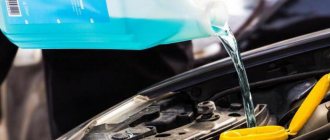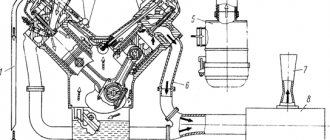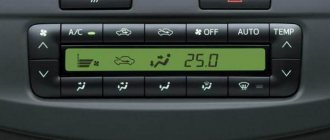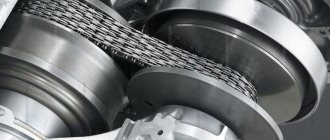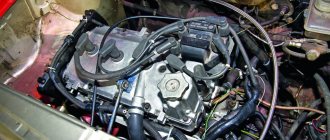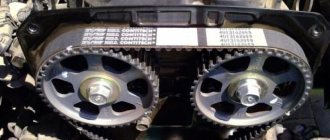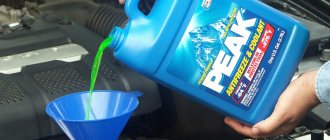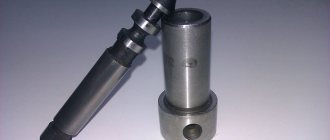Why do they cut out the catalyst on a car?
Such removal has negative consequences in the form of increased environmental pollution.
It is usually carried out for two reasons - saving on the purchase of a new part to replace one that has become unusable (the product is expensive for the reasons described above) and power tuning of the car.
Reducing exhaust resistance will allow the engine to rev more confidently. Moreover, it is no secret that environmental friendliness and efficiency cannot yet exist simultaneously. Servicing a good catalyst requires a significant amount of additional fuel that does not carry a payload.
Do-it-yourself washing of the car catalyst
Service station technicians unanimously claim that the catalyst cannot be repaired, and the only way to restore its functionality is to replace it with a new one. It is truly impossible to repair a unit that has exhausted its service life. It is worth remembering that this part is consumable and will sooner or later need to be replaced.
However, if the catalyst is simply clogged, cleaning or flushing will help extend its service life. You can do this yourself without turning to expensive specialists.
Each driver can wash the catalyst on his own
What and how to rinse
Carburetor fluid or ethanol works well for flushing a clogged catalyst. The procedure is carried out in a plastic container. The catalyst is removed from the car, checked for severe damage and cleaning begins.
The honeycomb is generously watered with cleaning liquid, then the part is wrapped in several layers of fabric and placed vertically in a plastic container. After 30 minutes, the honeycombs are washed with a stream of hot water.
After washing with water, the catalyst is purged to check the permeability of the honeycomb. If air passes through with difficulty, the part is again watered with liquid and washed with water. After complete cleaning, the part is thoroughly blown with compressed air and thoroughly dried with a powerful hair dryer.
In case of critical contamination, the procedure must be repeated 3-4 times or use a more aggressive agent. For washing, take kerosene and dilute it in a 4:1 ratio with solvent 646 or acetone. The catalyst is immersed in the resulting solution for a day, then purged or the above-described cleaning with an aerosol for carburetors and washing is carried out.
Video: how to clean with foam
It is important! Cleaning should not be done in the bathroom, since carburetor fluid can corrode the enamel of the bathtub and harm other interior parts.
Mechanical cleaning
Contaminants accumulated on the outside of the catalyst can be removed with fine sandpaper. Sandpaper will help in case of minor contamination of the part. Carbon deposits must be removed carefully so as not to damage the honeycombs due to excessive friction. After cleaning, the catalyst is blown with a stream of compressed air.
How to clean the catalyst without removing it from the car
For washing and preventive maintenance of catalysts, the industry offers a special fluid, for example, Hi-Gear HG3270. It is poured into the gas tank before refueling. As soon as the engine starts running, the fluid will begin cleaning the catalyst. The accumulated soot will be removed on its own through the exhaust pipe. Of course, environmentalists will not like this, but the engine will start working better.
How to check the catalyst for clogging without removing
The three most common methods for finding out that the device is clogged:
- Complete dismantling of the working unit and its external inspection for signs of clogging. Removing the part is sometimes problematic - the fastening becomes tightly stuck. In this case, the specialist uses an angle grinder. Also, some cars have such complex designs of exhaust systems that it is completely impossible to remove its elements or it takes several days.
- Measuring the pressure present in the exhaust system. To measure it, you need to install a pressure gauge in place of the 1st oxygen sensor, and then take readings at different engine operating modes. The correct pressure is considered to be 0.3 kgf/cm², at 2.5 thousand rpm. The disadvantage of the described method is that it is often difficult to remove the sensors; they can stick quite strongly to the outlet.
- Measuring back pressure using a special tester. A pressure sensor is mounted in the engine cylinder in place of the spark plug, after which the oscillogram is analyzed at increased speeds.
The catalyst definitely needs to be replaced or repaired in a situation where the pressure in the exhaust system exceeds 200 kPa (almost 2 kgf/cm²).
Original or analogue
The original catalyst is quite an expensive thing. It is not produced in our country, all parts in auto stores are imported, so duties affect the increase in price.
At the same time, if an original part is used, the car retains all engine operating modes. This has a positive effect on the environment, as well as on the service life of the motor.
All methods for replacing the catalyst described below are for informational purposes only. It is not recommended to use these methods on your own!
Due to the high price, car enthusiasts are looking for an alternative. There are several options:
- universal catalyst;
- flame arrester.
A universal catalyst means two groups of parts at once. The first is a catalyst suitable for any car. Quite an expensive thing, but it works flawlessly. The second option is a block with honeycombs. In this case, new honeycombs are installed in the old catalyst. The disadvantage of this option is that it is difficult to choose a service for repairs; not everyone will undertake such work. The service life of a universal neutralizer is 60–90 thousand kilometers.
Removing/Installing the catalyst
A cheaper and more common method is a flame arrester. It can be ready-made, simply intended for installation instead of a catalyst. Another option is to install a flame arrester directly into the neutralizer body. This method is somewhat more complicated, but it allows you to hide the fact that a part has been replaced when selling the car.
Sometimes drivers simply knock the honeycomb out of the housing. The method is cheap, but can lead to increased noise levels and environmental damage.
Causes of the problem
Why does the catalyst clog in VAZ (2114, Priora), Ford Focus, Skoda Octavia, Renault Logan, Nissan, Kia Rio, Opel and other cars?
The reason for this may be poor ventilation of the cylinders. When it weakens, the power unit cannot capture enough air - the increased back pressure of the catalyst interferes. The exhaust remains partially inside the cylinders and does not allow the air-fuel mixture to properly fill the combustion chamber. For this reason, the dynamics deteriorate and the power decreases. The main thing to know is if the catalyst is clogged, how the car behaves and why it is dangerous.
For the following reasons, the catalyst usually becomes clogged:
- There are certain defects in the engine or exhaust system. For example, increased oil content in the exhaust and increased consumption.
- Low-quality fuel, which does not completely burn out in the cylinders and burns out already in the exhaust manifold. Against this background, the catalyst may melt or simply overheat.
- The catalyst throughput cells are too small. They clog quickly and even small drops stick due to the high temperature.
In addition, the clogging of the catalyst is affected by poor-quality road surfaces. Its internal components suffer from constant mechanical impacts on uneven surfaces, speed bumps, and bumps. And if at least one honeycomb is damaged, then its particles can clog the remaining honeycombs.
Video of a clogged catalyst:
Useful tips
The video from the popular channel “Main Road” very clearly shows why catalysts are in cars, how to use them correctly, whether it is possible without them and what the dangers are.
To summarize the video, here are some useful tips below for those who have a catalyst installed in their car.
- The high price of the converter is explained by the use of precious metals in the design of the catalyst. Now engineers and chemists are trying to use gold, which is slightly cheaper than the metals already used to make catalysts.
- Taking good care of all vehicle systems is the key to their long service life. The catalyst is connected to other components of the car, and depends on their adequate operation.
- Choosing engine oil for a car with a catalyst is a different story. You only need oil that is marked as “suitable for modern exhaust gas after-treatment systems,” that is, catalysts on a gasoline engine and particulate filters on a diesel engine.
- Sticking piston rings means not only excessive oil consumption, but also rapid failure of the catalyst.
- A faulty autocatalyst itself, on the contrary, affects engine performance. Clogged honeycombs contribute to overheating of the CPG, since they do not allow exhaust gases to drain normally.
- The catalyst that is removed from the car (if it is replaced due to premature failure) contains precious metals. So you can either ask for a discount on the master’s work for it, or take it with you (though it’s not clear what to do next with this “treasure”). And only a fully used device costs nothing.
Consequences for the engine
We advise you not to neglect the advice on how to check the catalyst for cloggedness, since the consequences of driving with such a unit can be the most severe for the car. A faulty element causes the following problems:
- Gasoline operating costs increase due to increased exhaust tract resistance.
- Exhaust gases contain much more harmful substances.
- Engine power drops significantly, and, consequently, ride comfort.
- The main thing that threatens long-term driving with a clogged catalyst is complete breakdown of the gasoline engine. At one point it will stall while driving or will not start at all.
It is especially dangerous for the engine if the internal filling of the catalyst is destroyed. In this case, solid particles are formed that penetrate the cylinder and become clogged between the piston and the inner surface. They cause damage to the mirror and can only be removed by grinding and honing.
Price issue
Because The converter consists of plates coated with noble metals (most often iridium), its price cannot be low. For domestic cars, the price tag ranges from 10,000 to 20,000 rubles, for foreign cars - from 30,000 to 70,000 rubles. It is advisable to install it in service centers. Installation cost is 3,000-5,000 rubles.
Please note: on the secondary auto parts market there are a huge number of advertisements for the sale of used neutralizers. It’s not worth purchasing them: no matter what the seller says, this does not guarantee that the device will work. And it is impossible to check the condition of its filters without analysis.
Subtleties of removing the device from the exhaust system
It is sometimes impossible to do this without a significant investment of time. Gone are the days when the catalyst was an easy-to-handle tin cylinder with a fragile ceramic filling. Two strong blows with a crowbar - and the job is done.
Now we have to deal with a product of an intricate shape, without access to the insides, and even with strong metal honeycombs. You have to open the case and then weld it. In the conditions of a service station, the operation is not the cheapest.
On the subject: Why oil leaks from the engine, how to find and fix the leak
The process must be completed by reconfiguring the “brains” of the engine, otherwise they will immediately figure out the deception. This is done in various ways, depending on the qualifications and habits of the performer. Both software and hardware “tricks” of monitoring sensors can be used.
The result is the same - the engine adapts to new conditions and stops panicking with the “Check engine” light. Sometimes they install a so-called flame arrester - a special welding that normalizes the sound, temperature and internal aerodynamics of the exhaust.
